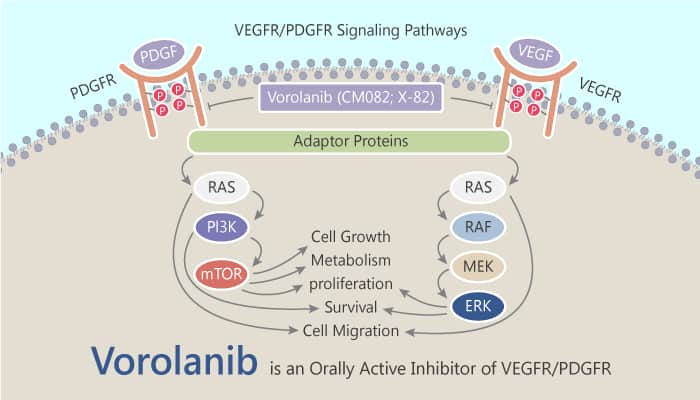Vascular endothelial growth factor receptor (VEGFR) and platelet-derived growth factor receptor (PDGFR) are cell-surface tyrosine kinase receptors. They represent targets for anticancer therapy in solid tumors. For accurately validating the therapeutic potential of these target-specific agents, the in vivo quantification of VEGFR/PDGFR activity is critically important. It is not only for establishing the treatment indication but also for monitoring the therapeutic efficacy. In order to directly evaluate the distribution and concentration of VEGFR / PDGFR, it is necessary to develop magnetic resonance (MR) probes. This is because MR probes can actively target related receptors. Small molecule receptor tyrosine kinase inhibitor (RTKIs) is a suitable candidate ligand, which can be used to design active target probes. Because they have a receptor-specific affinity, and their simple structure can make direct binding to imaging contrast materials. Vorolanib (CM082; X-82) is an orally active, multikinase VEGFR/PDGFR inhibitor with antitumor activity.

Vorolanib (CM082; X-82) is an orally active, multikinase VEGFR/PDGFR inhibitor. Clinical studies showed sunitinib has a long t1/2 (>40 hours) as well as large distribution and accumulation in various tissues. By targeting the VEGF and PDGF receptors, Vorolanib can disrupt tumor angiogenesis. And Vorolanib is active in a broad spectrum of solid tumors. Vorolanib has also been designed to be less distributed in tissues because its therapeutic targets are located in blood vessels. T1/2 of Vorolanib is short and does not accumulate in tissues. So it will meet the requirements of intermittent inhibition and minimize the toxicity potential. Furthermore, it maintains the antitumor activity similar to sunitinib. All in all, Vorolanib is an orally active, multikinase VEGFR and PDGFR inhibitor with antitumor activity.
References:
Bendell JC, et al. Oncologist. 2019 Apr;24(4):455-e121.